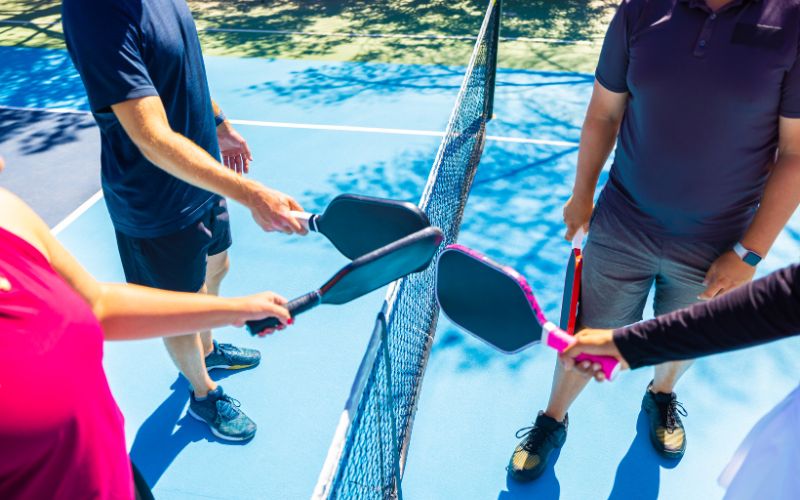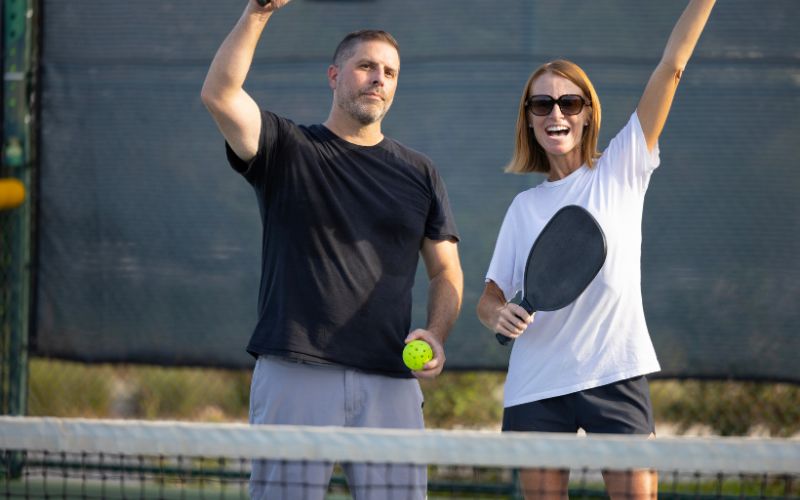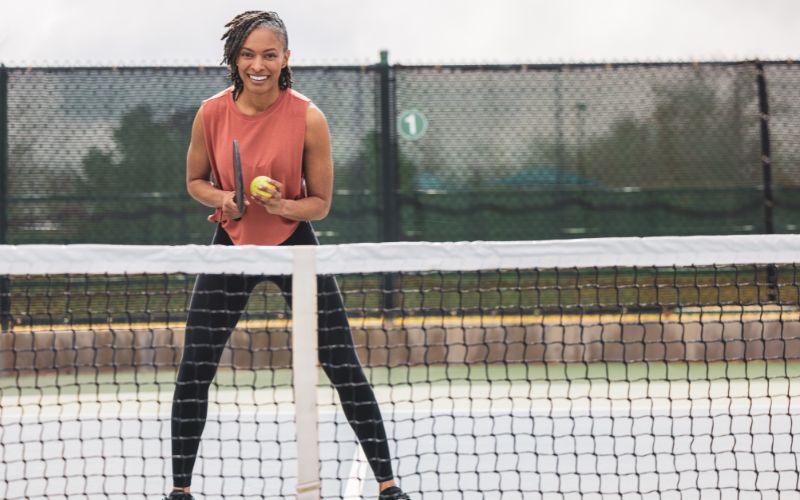Pickleball, a rapidly growing sport, combines elements of tennis, badminton, and ping pong, captivating players of all ages. Whether you’re a seasoned pro or just starting, incorporating the best exercises for pickleball into your routine is essential for enhancing your performance on the court. In this comprehensive guide, we’ll explore a variety of exercises targeting different aspects of your body, with a focus on both upper body and lower body strength, balance, and injury prevention.
Importance of Exercise in Pickleball
The Growing Popularity of Pickleball
Pickleball has emerged as one of the fastest-growing sports, attracting enthusiasts worldwide. Its dynamic nature requires players to possess a unique blend of skills, agility, and strategic thinking. To excel in this sport, a comprehensive approach to fitness, including targeted exercises, is crucial.
Positive Impact of Exercise on Pickleball Performance
Engaging in regular exercise has a profound and positive impact on pickleball performance. It not only enhances physical fitness but also contributes to improved reaction time, agility, and overall game proficiency.
Essential Muscle Groups in Pickleball
Pickleball, a sport experiencing rapid global growth, presents unique challenges to various aspects of physical fitness, including reaction time, agility, hand-eye coordination, power, and balance.
Being primarily an aerobic sport, pickleball demands sustained energy throughout matches that can extend from 20 minutes to 1-2 hours. Additionally, it involves intermittent bursts of high-intensity activity, encompassing rapid sprints, directional changes, and quick reactions/volleys at the net.
Critical for pickleball athletes is strength in both the lower and upper extremities. A robust and stable lower extremity contributes to effective on-court movements, balance maintenance, and agile changes in direction. Simultaneously, upper extremity strength and muscular endurance are vital for shot production and delaying muscular fatigue.
In the context of force transmission, the trunk plays a pivotal role in maintaining stability, postural integrity, and facilitating the transfer of forces from the lower to upper extremity. Similar to other racket sports, effective force summation occurs as athletes generate force from the ground through the legs, channeling it up through the trunk to the upper extremity.
Upper Body Strength Exercises
Strength Training exercises for the Arms for Power Shots
- Lifting Weights for Upper Body Strength
Incorporate weight lifting exercises to target the arms, shoulders, and back. This builds the necessary strength for powerful shots during a pickleball game. - Palms Facing Split Squats
Execute split squats with palms facing each other to engage the shoulders, upper back, and arms. This exercise enhances strength and coordination, essential for effective gameplay.
Core Engagement for Stability and Control
- Medicine Ball Exercises for Core Stability
Integrate medicine ball exercises into your routine to engage the core, shoulders, and back muscles. A strong core provides stability during shots and contributes to overall control on the court. - More Power through Core Engagement
Ensure your core is engaged during upper body exercises. This not only enhances stability but also plays a vital role in generating more power during your pickleball shots.
Lower Body Strength and Balance Exercises
Building Leg Muscles for Stability
- Goblet Squats for Full Body Engagement
Incorporate goblet squats into your routine to engage multiple muscle groups simultaneously. This exercise targets the legs, core, and upper body, providing a comprehensive lower body workout. - Dynamic Split Squats for Explosive Power
Execute dynamic split squats to enhance explosive power in your legs. This mirrors the movements required in pickleball, promoting agility and quick changes of direction.
Single Leg Balance for Stability
- One-Foot Lifts for Improved Stability
Practice one-foot lifts to enhance balance and coordination. This exercise strengthens stabilizing muscles in the lower body, crucial for precise movements on the pickleball court. - Switch Legs for Balanced Development
When performing unilateral exercises, such as lunges or step-ups, remember to switch legs. This promotes balanced muscle development, preventing strength imbalances that could impact your pickleball performance.
Best Pickleball Exercises for Pickleball Players
Multi-Directional Lunges Lunges stand out as an exceptional exercise for athletes, offering considerable versatility in terms of loading and the various planes of movement and body positions that can be addressed.
Given the multi-directional nature of movement and diverse positions encountered in pickleball, incorporating lunges in various directions is sure to enhance your on-court movement, strength, and balance.
1. Multi-Planar Single-Leg Hurdle Jumps
Engaging in single-leg countermovement jumps proves to be an excellent workout for athletes, particularly those actively involved in pickleball. This exercise targets stability in the ankle, knee, and hip, emphasizing balance and power. Regular incorporation of these jumps contributes to improved on-court balance and maneuverability.
Begin the exercise with 6” mini hurdles, starting with linear jumps. Execute a countermovement by hinging at the hips, with a slight knee bend on the working leg. Jump over the hurdle or cone and land in a controlled manner, aiming for a landing position identical to a freeze-frame of the bottom of your countermovement. Stand upright, then repeat the countermovement before jumping over the remaining hurdles.
Apply the same technique to lateral jumps, ensuring that the shoulders and hips remain square without rotating in the direction of movement. As entry-level progressions, cones or markers on the ground can also be utilized.
2. Trap Bar Deadlift Technique
Engaging in trap bar deadlifts proves to be an effective exercise for building overall body strength, with a specific emphasis on the glutes, hamstrings, lower back, and core. The design of the trap bar handles makes this exercise user-friendly, suitable for athletes of varying experience levels.
In the starting position, ensure straight arms, elbows positioned outside the knees, and the back at a 45-degree angle. It’s important not to reach a full squat position.
Initiate the movement by pressing the feet into the floor, maintaining stability in the core and trunk while ensuring that the shoulders and hips move simultaneously at a consistent rate.
Upon reaching the finishing position, focus on squeezing the glutes and keeping the core braced, aiming to stand as tall as possible. It’s crucial to avoid forcefully thrusting the hips forward at the conclusion of the movement.
When lowering the bar back to the floor, ensure that the shoulders and hips move in unison, maintaining a controlled descent.
3. Kettlebell Swings Technique
Kettlebell swings are a highly efficient way to target the hips, glutes, hamstrings, and the muscles supporting proper posture in the back.
Given the considerable duration spent in low positions while playing on the court, it is imperative for pickleball athletes to possess resilient and strong musculature along the posterior chain.
When performing kettlebell swings, focus on executing a hip hinge by pushing the hips backward, ensuring that the trunk remains parallel to the ground. Keep the kettlebell at or above the level of the knees during the downward phase of the swing.
4. Weighted Walks
Start by grasping a dumbbell or kettlebell in both hands. Stand with excellent, erect posture, ensuring a braced core, shoulders pulled back, and head held high.
Proceed to walk in a linear path, sustaining the aforementioned posture throughout. The weight of the dumbbell or kettlebell should provide a moderate to heavy resistance. It’s crucial to challenge yourself, considering this exercise as a weighted abdominal workout that aids in pushing beyond your current capabilities.
Once you feel at ease, advance to a unilateral variation, utilizing only one dumbbell or kettlebell.
5. Box Jumps Technique
Utilizing box jumps proves to be an excellent method for enhancing power in the lower extremities.
Initiate the exercise by positioning yourself facing the box. Swiftly lower your body, then explosively push upward, intending to land gently on the top of the box with the entire foot making contact.
Place less emphasis on the height of the box and instead concentrate on executing the “down-up” motion of the jump swiftly, ensuring a controlled landing.
Injury Prevention and Recovery
Prioritizing Injury Prevention
- Proper Warm-Up to Prevent Injuries
Emphasize the importance of a proper warm-up before engaging in pickleball or any exercise routine. Warming up prepares your muscles, reduces the risk of strains, and enhances overall flexibility. - Rest and Recovery
Acknowledge the significance of rest in preventing injuries. Adequate rest allows your muscles to recover, reducing the risk of overuse injuries commonly associated with sports like pickleball.
Addressing Common Issues such as Ankle Sprains
- Heel Raises for Ankle Strengthening
Perform heel raises to strengthen the ankles. Strong ankles are crucial for stability on the court and can help prevent common issues like ankle sprains. - Toe Taps for Improved Footwork
Incorporate toe taps into your routine to enhance footwork and agility. This simple exercise contributes to better maneuverability and reduces the risk of injuries associated with rapid directional changes.
Pickleball-Specific Exercises
Mimicking Game Movements for Skill Enhancement
- Ready Position Simulation
Incorporate exercises that simulate the ready position in pickleball. This involves a slightly bent stance with the knees and elbows, preparing your body for quick movements and reactions during the game. - Reaction Time Exercises
Include reaction time exercises in your routine to improve responsiveness on the court. Quick reactions are essential for effectively countering opponents’ moves during a pickleball game.
Tailoring Exercises for Pickleball Players of All Ages
Exercises for Older Adults
- Low-Impact Lunges for Seniors
Modify lunges to make them low-impact for older adults. This ensures they can still benefit from leg strength exercises without putting excessive strain on joints. - Balance Exercises for Stability
Prioritize balance exercises for older players. Enhancing stability is crucial for preventing falls and injuries, promoting a safe and enjoyable pickleball experience.
Conclusion: Elevate Your Pickleball Game with Strategic Exercises
In conclusion, the best exercises for pickleball encompass a holistic approach, targeting various muscle groups, balance, and agility. Whether you’re aiming to enhance your strength, prevent injuries, or mimic game movements, incorporating a diverse range of exercises into your routine can significantly impact your performance on the court.
Remember, pickleball is not just a game; it’s a dynamic sport that demands physical fitness and strategic thinking. By dedicating time to these tailored exercises, you’ll not only boost your strength but also elevate your overall pickleball game. So, grab your paddle, follow these exercise guidelines, and get ready to outplay your opponents with finesse and skill on the pickleball court.







